Song Gao
SREC: Encrypted Semantic Super-Resolution Enhanced Communication
Sep 05, 2025Abstract:Semantic communication (SemCom), as a typical paradigm of deep integration between artificial intelligence (AI) and communication technology, significantly improves communication efficiency and resource utilization efficiency. However, the security issues of SemCom are becoming increasingly prominent. Semantic features transmitted in plaintext over physical channels are easily intercepted by eavesdroppers. To address this issue, this paper proposes Encrypted Semantic Super-Resolution Enhanced Communication (SREC) to secure SemCom. SREC uses the modulo-256 encryption method to encrypt semantic features, and employs super-resolution reconstruction method to improve the reconstruction quality of images. The simulation results show that in the additive Gaussian white noise (AWGN) channel, when different modulation methods are used, SREC can not only stably guarantee security, but also achieve better transmission performance under low signal-to-noise ratio (SNR) conditions.
SemSteDiff: Generative Diffusion Model-based Coverless Semantic Steganography Communication
Sep 05, 2025Abstract:Semantic communication (SemCom), as a novel paradigm for future communication systems, has recently attracted much attention due to its superiority in communication efficiency. However, similar to traditional communication, it also suffers from eavesdropping threats. Intelligent eavesdroppers could launch advanced semantic analysis techniques to infer secret semantic information. Therefore, some researchers have designed Semantic Steganography Communication (SemSteCom) scheme to confuse semantic eavesdroppers. However, the state-of-the-art SemSteCom schemes for image transmission rely on the pre-selected cover image, which limits the universality. To address this issue, we propose a Generative Diffusion Model-based Coverless Semantic Steganography Communication (SemSteDiff) scheme to hide secret images into generated stego images. The semantic related private and public keys enable legitimate receiver to decode secret images correctly while the eavesdropper without completely true key-pairs fail to obtain them. Simulation results demonstrate the effectiveness of the plug-and-play design in different Joint Source-Channel Coding (JSCC) frameworks. The comparison results under different eavesdroppers' threats show that, when Signal-to-Noise Ratio (SNR) = 0 dB, the peak signal-to-noise ratio (PSNR) of the legitimate receiver is 4.14 dB higher than that of the eavesdropper.
KGRAG-SC: Knowledge Graph RAG-Assisted Semantic Communication
Sep 05, 2025
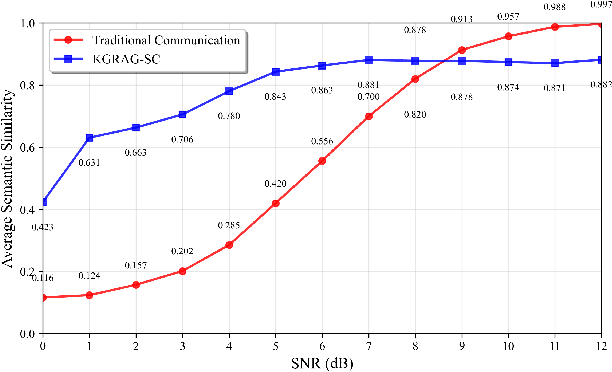
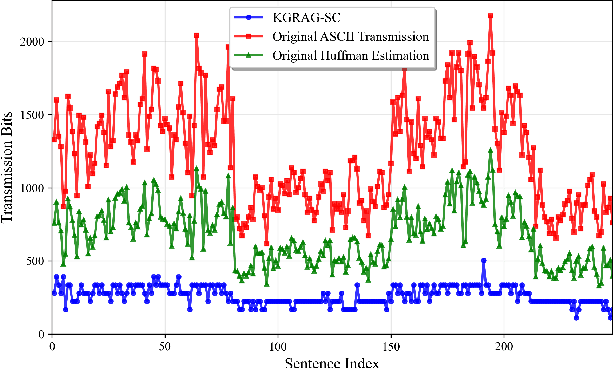
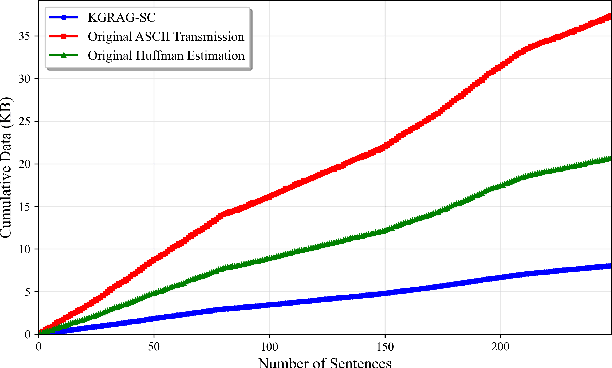
Abstract:The state-of-the-art semantic communication (SC) schemes typically rely on end-to-end deep learning frameworks that lack interpretability and struggle with robust semantic selection and reconstruction under noisy conditions. To address this issue, this paper presents KGRAG-SC, a knowledge graph-assisted SC framework that leverages retrieval-augmented generation principles. KGRAG-SC employs a multi-dimensional knowledge graph, enabling efficient semantic extraction through community-guided entity linking and GraphRAG-assisted processing. The transmitter constructs minimal connected subgraphs that capture essential semantic relationships and transmits only compact entity indices rather than full text or semantic triples. An importance-aware adaptive transmission strategy provides unequal error protection based on structural centrality metrics, prioritizing critical semantic elements under adverse channel conditions. At the receiver, large language models perform knowledge-driven text reconstruction using the shared knowledge graph as structured context, ensuring robust semantic recovery even with partial information loss. Experimental results demonstrate that KGRAG-SC achieves superior semantic fidelity in low Signal-to-Noise Ratio (SNR) conditions while significantly reducing transmission overhead compared to traditional communication methods, highlighting the effectiveness of integrating structured knowledge representation with generative language models for SC systems.
Whose Truth? Pluralistic Geo-Alignment for (Agentic) AI
Aug 07, 2025Abstract:AI (super) alignment describes the challenge of ensuring (future) AI systems behave in accordance with societal norms and goals. While a quickly evolving literature is addressing biases and inequalities, the geographic variability of alignment remains underexplored. Simply put, what is considered appropriate, truthful, or legal can differ widely across regions due to cultural norms, political realities, and legislation. Alignment measures applied to AI/ML workflows can sometimes produce outcomes that diverge from statistical realities, such as text-to-image models depicting balanced gender ratios in company leadership despite existing imbalances. Crucially, some model outputs are globally acceptable, while others, e.g., questions about Kashmir, depend on knowing the user's location and their context. This geographic sensitivity is not new. For instance, Google Maps renders Kashmir's borders differently based on user location. What is new is the unprecedented scale and automation with which AI now mediates knowledge, expresses opinions, and represents geographic reality to millions of users worldwide, often with little transparency about how context is managed. As we approach Agentic AI, the need for spatio-temporally aware alignment, rather than one-size-fits-all approaches, is increasingly urgent. This paper reviews key geographic research problems, suggests topics for future work, and outlines methods for assessing alignment sensitivity.
Generative Diffusion Models for Wireless Networks: Fundamental, Architecture, and State-of-the-Art
Jul 22, 2025Abstract:With the rapid development of Generative Artificial Intelligence (GAI) technology, Generative Diffusion Models (GDMs) have shown significant empowerment potential in the field of wireless networks due to advantages, such as noise resistance, training stability, controllability, and multimodal generation. Although there have been multiple studies focusing on GDMs for wireless networks, there is still a lack of comprehensive reviews on their technological evolution. Motivated by this, we systematically explore the application of GDMs in wireless networks. Firstly, starting from mathematical principles, we analyze technical advantages of GDMs and present six representative models. Furthermore, we propose the multi-layer wireless network architecture including sensing layer, transmission layer, application layer, and security plane. We also introduce the core mechanisms of GDM at each of the layers. Subsequently, we conduct a rigorous review on existing GDM-based schemes, with a focus on analyzing their innovative points, the role of GDMs, strengths, and weaknesses. Ultimately, we extract key challenges and provide potential solutions, with the aim of providing directional guidance for future research in this field.
AutoSDT: Scaling Data-Driven Discovery Tasks Toward Open Co-Scientists
Jun 09, 2025Abstract:Despite long-standing efforts in accelerating scientific discovery with AI, building AI co-scientists remains challenging due to limited high-quality data for training and evaluation. To tackle this data scarcity issue, we present AutoSDT, an automatic pipeline that collects high-quality coding tasks in real-world data-driven discovery workflows. AutoSDT leverages the coding capabilities and parametric knowledge of LLMs to search for diverse sources, select ecologically valid tasks, and synthesize accurate task instructions and code solutions. Using our pipeline, we construct AutoSDT-5K, a dataset of 5,404 coding tasks for data-driven discovery that covers four scientific disciplines and 756 unique Python packages. To the best of our knowledge, AutoSDT-5K is the only automatically collected and the largest open dataset for data-driven scientific discovery. Expert feedback on a subset of 256 tasks shows the effectiveness of AutoSDT: 93% of the collected tasks are ecologically valid, and 92.2% of the synthesized programs are functionally correct. Trained on AutoSDT-5K, the Qwen2.5-Coder-Instruct LLM series, dubbed AutoSDT-Coder, show substantial improvement on two challenging data-driven discovery benchmarks, ScienceAgentBench and DiscoveryBench. Most notably, AutoSDT-Coder-32B reaches the same level of performance as GPT-4o on ScienceAgentBench with a success rate of 7.8%, doubling the performance of its base model. On DiscoveryBench, it lifts the hypothesis matching score to 8.1, bringing a 17.4% relative improvement and closing the gap between open-weight models and GPT-4o.
Foundation Models for Geospatial Reasoning: Assessing Capabilities of Large Language Models in Understanding Geometries and Topological Spatial Relations
May 22, 2025
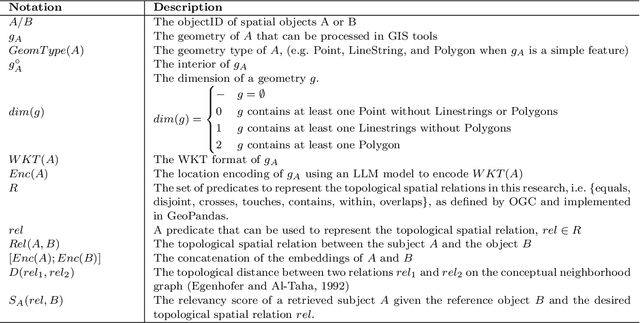
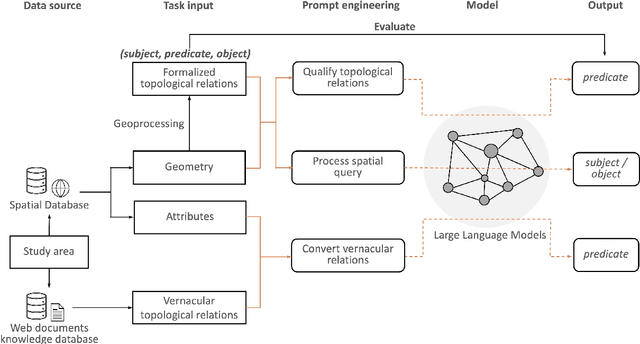

Abstract:Applying AI foundation models directly to geospatial datasets remains challenging due to their limited ability to represent and reason with geographical entities, specifically vector-based geometries and natural language descriptions of complex spatial relations. To address these issues, we investigate the extent to which a well-known-text (WKT) representation of geometries and their spatial relations (e.g., topological predicates) are preserved during spatial reasoning when the geospatial vector data are passed to large language models (LLMs) including GPT-3.5-turbo, GPT-4, and DeepSeek-R1-14B. Our workflow employs three distinct approaches to complete the spatial reasoning tasks for comparison, i.e., geometry embedding-based, prompt engineering-based, and everyday language-based evaluation. Our experiment results demonstrate that both the embedding-based and prompt engineering-based approaches to geospatial question-answering tasks with GPT models can achieve an accuracy of over 0.6 on average for the identification of topological spatial relations between two geometries. Among the evaluated models, GPT-4 with few-shot prompting achieved the highest performance with over 0.66 accuracy on topological spatial relation inference. Additionally, GPT-based reasoner is capable of properly comprehending inverse topological spatial relations and including an LLM-generated geometry can enhance the effectiveness for geographic entity retrieval. GPT-4 also exhibits the ability to translate certain vernacular descriptions about places into formal topological relations, and adding the geometry-type or place-type context in prompts may improve inference accuracy, but it varies by instance. The performance of these spatial reasoning tasks offers valuable insights for the refinement of LLMs with geographical knowledge towards the development of geo-foundation models capable of geospatial reasoning.
* 33 pages, 13 figures, IJGIS GeoFM Special Issue
GeoRanker: Distance-Aware Ranking for Worldwide Image Geolocalization
May 19, 2025Abstract:Worldwide image geolocalization-the task of predicting GPS coordinates from images taken anywhere on Earth-poses a fundamental challenge due to the vast diversity in visual content across regions. While recent approaches adopt a two-stage pipeline of retrieving candidates and selecting the best match, they typically rely on simplistic similarity heuristics and point-wise supervision, failing to model spatial relationships among candidates. In this paper, we propose GeoRanker, a distance-aware ranking framework that leverages large vision-language models to jointly encode query-candidate interactions and predict geographic proximity. In addition, we introduce a multi-order distance loss that ranks both absolute and relative distances, enabling the model to reason over structured spatial relationships. To support this, we curate GeoRanking, the first dataset explicitly designed for geographic ranking tasks with multimodal candidate information. GeoRanker achieves state-of-the-art results on two well-established benchmarks (IM2GPS3K and YFCC4K), significantly outperforming current best methods.
Image Steganography For Securing Intellicise Wireless Networks: "Invisible Encryption" Against Eavesdroppers
May 07, 2025Abstract:As one of the most promising technologies for intellicise (intelligent and consice) wireless networks, Semantic Communication (SemCom) significantly improves communication efficiency by extracting, transmitting, and recovering semantic information, while reducing transmission delay. However, an integration of communication and artificial intelligence (AI) also exposes SemCom to security and privacy threats posed by intelligent eavesdroppers. To address this challenge, image steganography in SemCom embeds secret semantic features within cover semantic features, allowing intelligent eavesdroppers to decode only the cover image. This technique offers a form of "invisible encryption" for SemCom. Motivated by these advancements, this paper conducts a comprehensive exploration of integrating image steganography into SemCom. Firstly, we review existing encryption techniques in SemCom and assess the potential of image steganography in enhancing its security. Secondly, we delve into various image steganographic paradigms designed to secure SemCom, encompassing three categories of joint source-channel coding (JSCC) models tailored for image steganography SemCom, along with multiple training strategies. Thirdly, we present a case study to illustrate the effectiveness of coverless steganography SemCom. Finally, we propose future research directions for image steganography SemCom.
GIScience in the Era of Artificial Intelligence: A Research Agenda Towards Autonomous GIS
Apr 01, 2025Abstract:The advent of generative AI exemplified by large language models (LLMs) opens new ways to represent and compute geographic information and transcend the process of geographic knowledge production, driving geographic information systems (GIS) towards autonomous GIS. Leveraging LLMs as the decision core, autonomous GIS can independently generate and execute geoprocessing workflows to perform spatial analysis. In this vision paper, we elaborate on the concept of autonomous GIS and present a framework that defines its five autonomous goals, five levels of autonomy, five core functions, and three operational scales. We demonstrate how autonomous GIS could perform geospatial data retrieval, spatial analysis, and map making with four proof-of-concept GIS agents. We conclude by identifying critical challenges and future research directions, including fine-tuning and self-growing decision cores, autonomous modeling, and examining the ethical and practical implications of autonomous GIS. By establishing the groundwork for a paradigm shift in GIScience, this paper envisions a future where GIS moves beyond traditional workflows to autonomously reason, derive, innovate, and advance solutions to pressing global challenges.
 Add to Chrome
Add to Chrome Add to Firefox
Add to Firefox Add to Edge
Add to Edge